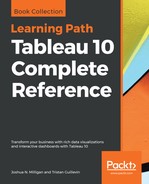Calculations open up amazing possibilities in Tableau. You are no longer confined to the fields in the source data. With calculations, you can extend the data by adding new dimensions and measures, fix bad or poorly, formatted data, enhance the user experience with parameters for user input and calculations that enhance the visualizations, and you can achieve flexibility that makes data blending work in situations where the data might have made it difficult or impossible otherwise.
The key to using calculated fields is an understanding of the three levels of calculations in Tableau. The Row Level calculations are performed for every row of source data. These calculated fields can be used as dimensions or they can be further aggregated as measures. Aggregate Level calculations are performed at the level of detail defined by the dimensions present in a view. They are especially helpful, and even necessary when you must first aggregate components of the calculation before performing additional operations. Level of Detail calculations allows you to perform aggregations at any level of detail, even if it doesn't match that of the view.
In the next chapter, we'll explore the third main type of calculations: Table Calculations. These are some of the most powerful calculations in terms of their ability to solve problems and open up incredible possibilities for in-depth analysis. In practice, they range from very easy to exceptionally complex.
